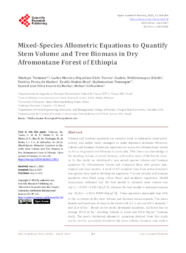Mixed-Species allometric equations to quantify stem volume and tree biomass in Dry Afromontane Forest of Ethiopia.
Mixed-Species allometric equations to quantify stem volume and tree biomass in Dry Afromontane Forest of Ethiopia.
Summary: ABSTRACT. Volume and biomass equations are essential tools to determine forest productivity and enable forest managers to make informed ecisions. However, volume and biomass estimation equations are scarce for Afromontane forests in Africa in general and Ethiopia in particular. This limits our knowledge of the standing volume of wood, biomass, and carbon stock of the forests there in. In this study, we developed a new mixed-species volume and biomass equations for Afromontane forests and compared them with generic pantropical and local models. A total of 193 sampled trees from seven dominant tree species were used to develop the equations. Various volume and biomass equations were fitted using robust linear and nonlinear regression. Model comparison indicated that the best model to estimate stem volume was ln (v) = -9.909 + 0.954 * ln (d2h), whereas the best model to estimate biomass was ln (b) = -2.983 + 0.949 *ln (pd2h). These equations explained over 85% of the variations in the stem volume and biomass measurements. The mean density and basal area of trees in the forest with d >/= 2 cm was 631.5 stems-ha -1 and 24.4 m 2 ha -1. Based on the newly developed equations, the forest has on average 303.0 m3 ha -1 standing volume of wood and 283.8 Mg.ha -1 biomass stock. The newly developed allometric equations derived from this study can be used to accurately determine the stem volume, biomass, and carbon storage in the Afromontane forests in Ethiopia and elsewhere with similar stand characteristics and ecological conditions. By contrast, the generic pan-tropical and other local models appear to provide biased estimates and are not suitable for dry Afromontane forests in Ethiopia. The estimated stem biomass and carbon stock in the Chilimo forest are comparable with the estimates from various tropical forests and woodlands elsewhere in Africa, indicating the importance of dry Afromontane forest for climate change mitigation.
Publication year: 2022
Types of publication: Journal article
Unit: Embrapa Forestry
Observation
Some of Embrapa's publications are published as ePub files. To read them, use or download one of the following free software options to your computer or mobile device. Android: Google Play Books; IOS: iBooks; Windows and Linux: Calibre.
Access other publications
Access the Agricultural Research Database (BDPA) to consult Embrapa's full library collection and records.
Visit Embrapa Bookstore to purchase books and other publications sold by Embrapa.

